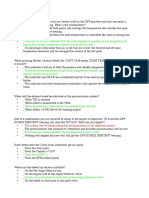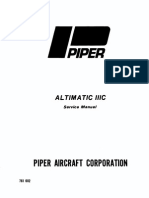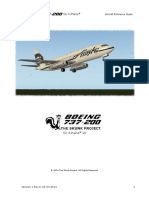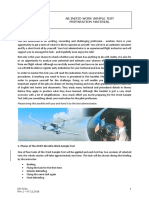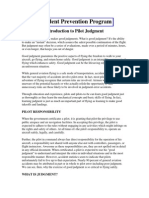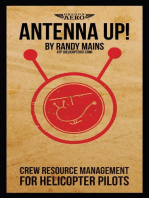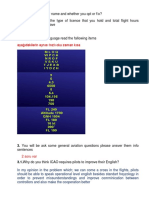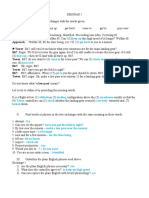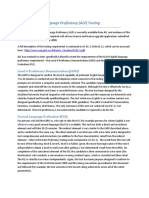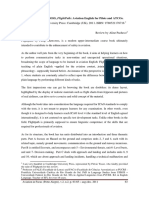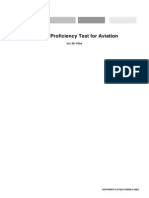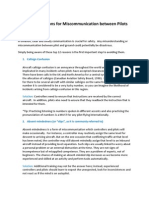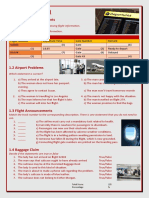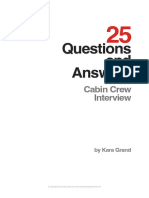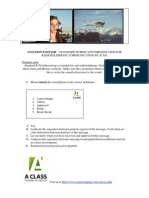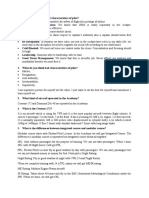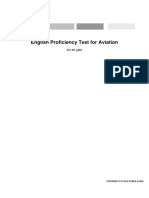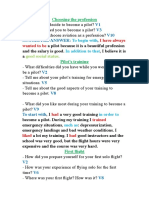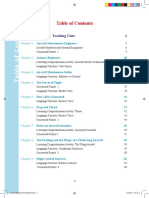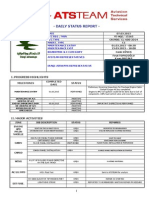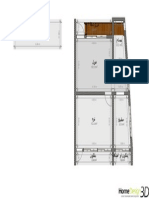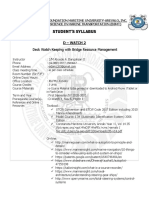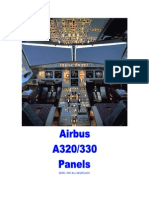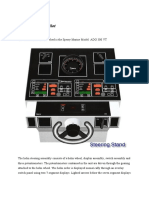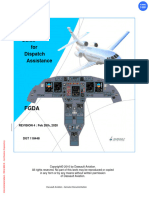100%(1)100% found this document useful (1 vote)
120 viewsFly The Dog: Pilot Errors From A Pilot Perspective
Fly The Dog: Pilot Errors From A Pilot Perspective
Uploaded by
IBooeingNGThis document discusses areas of pilot error from the perspective of a pilot. It argues that while simulator training focuses on flying skills and checklists, most accidents are caused by factors like poor self-discipline, ineffective communication in the cockpit, and failure to properly follow standard operating procedures. The document recommends pilots improve in two key areas - self-discipline, such as writing clearly and attentively using checklists, and cockpit resource management like cross-checking switches and monitoring other pilots. Adhering to standard operating procedures is also emphasized, as they are often made in response to past accidents.
Copyright:
© All Rights Reserved
Available Formats
Download as PDF, TXT or read online from Scribd
Fly The Dog: Pilot Errors From A Pilot Perspective
Fly The Dog: Pilot Errors From A Pilot Perspective
Uploaded by
IBooeingNG100%(1)100% found this document useful (1 vote)
120 views13 pagesThis document discusses areas of pilot error from the perspective of a pilot. It argues that while simulator training focuses on flying skills and checklists, most accidents are caused by factors like poor self-discipline, ineffective communication in the cockpit, and failure to properly follow standard operating procedures. The document recommends pilots improve in two key areas - self-discipline, such as writing clearly and attentively using checklists, and cockpit resource management like cross-checking switches and monitoring other pilots. Adhering to standard operating procedures is also emphasized, as they are often made in response to past accidents.
Original Description:
Pilot errors from a pilot perspective
Original Title
fly_the_dog
Copyright
© © All Rights Reserved
Available Formats
PDF, TXT or read online from Scribd
Share this document
Did you find this document useful?
Is this content inappropriate?
This document discusses areas of pilot error from the perspective of a pilot. It argues that while simulator training focuses on flying skills and checklists, most accidents are caused by factors like poor self-discipline, ineffective communication in the cockpit, and failure to properly follow standard operating procedures. The document recommends pilots improve in two key areas - self-discipline, such as writing clearly and attentively using checklists, and cockpit resource management like cross-checking switches and monitoring other pilots. Adhering to standard operating procedures is also emphasized, as they are often made in response to past accidents.
Copyright:
© All Rights Reserved
Available Formats
Download as PDF, TXT or read online from Scribd
Download as pdf or txt
100%(1)100% found this document useful (1 vote)
120 views13 pagesFly The Dog: Pilot Errors From A Pilot Perspective
Fly The Dog: Pilot Errors From A Pilot Perspective
Uploaded by
IBooeingNGThis document discusses areas of pilot error from the perspective of a pilot. It argues that while simulator training focuses on flying skills and checklists, most accidents are caused by factors like poor self-discipline, ineffective communication in the cockpit, and failure to properly follow standard operating procedures. The document recommends pilots improve in two key areas - self-discipline, such as writing clearly and attentively using checklists, and cockpit resource management like cross-checking switches and monitoring other pilots. Adhering to standard operating procedures is also emphasized, as they are often made in response to past accidents.
Copyright:
© All Rights Reserved
Available Formats
Download as PDF, TXT or read online from Scribd
Download as pdf or txt
You are on page 1of 13
1
by Captain Pat BOONE
Pilot errors from a pilot perspective
While aircraft systems have become more reliable over time, pilot human
behavior becomes the most critical factor affecting aviation safety today.
Simulator training often focuses on flying skills and the correct execution of
emergency checklists and standard operating procedures (SOPs). However,
statistics show that aircraft accidents seldom involve typical simulator trained
failures. Should we focus on something else ?
Engine failure, loss of all electric generators
or cabin decompression rarely result in fatal
accidents, although the latter one can
become overwhelming. An inextinguishable
engine fire is not a life-threatening event,
despite scare stories that the wing drops off
if the engine burns for 10 minutes or more.
Similar to the Loch Ness monster, no one
has ever experienced this event in a modern
aircraft. All-engine flameout due to heavy
rain, ice crystals or volcanic ash has occurred
in real life, but has not led to a fatal crash in
the past few decades.
I would even go as far as to say that none of
the failures instructed in the simulator, if they
are managed correctly with an appropriate
flight crew response, ever compromise the
aircraft to the extent of a fatal crash, except
for the following:
Jammed or restricted flight controls: Your
aircraft is not responding to control wheel
inputs, or a flight control is jammed fully
deflected. I recommend to try to regain
control through flight controls and engine
secondary effects.
Unreliable flight instruments: Airspeed,
altimeter or attitude indicators showing
confusing or even contradictory values,
for example overspeed and stall warning
go off simultaneously. My advice is to
freeze the aircraft attitude for a few
seconds until both pilots determine which
indicator is working correctly.
Fly the
Dog
PHOTO: Brett B. Despain
2
Cabin fire: Any fire starting inside the
fuselage can destroy the aircraft in only a
few minutes. Videos on the internet show
flames coming out the aircraft ceiling only
minutes after the fire ignited. My advice is
to initiate an immediate descent and
consider an off-field landing as soon as
the cabin crew reports flame height
exceeding 1 meter / 3 feet, even when
crossing 40 west over the Atlantic.
This doesnt mean simulator training is
useless. On the contrary you need to
practice those skills in order to fly the aircraft
safely. However, simulator training should
not solely focus on type-rating requirements.
In fact, if you double or triple the simulator
hours, almost anyone, including your mother
in law, can fly an ILS without any previous
flying experience.
Flying a perfect ILS does not
make you a safe pilot.
So, why are we still crashing airplanes? Why
do aircraft in perfect condition continue to
skid off the runway every month? Its no
secret that 6 out of 10 accidents are caused
by pilot error, of which nearly half during
landing. Flying an ILS with perfect precision
does not make you a safe pilot. Its not pilot
skills, but people skills that make the
difference between an ordinary pilot and a
safe pilot. Becoming a safe pilot should be
your ultimate goal.
While pilot error can never be eradicated,
there are two areas in which I believe, from a
pilot perspective, it is possible to make the
difference and become safer pilots. These
areas are self-discipline and Cockpit
Resource Management (CRM).
Self-discipline
Besides flying skills and sound judgment,
self-discipline is the third keystone of good
airmanship. Unfortunately, there are several
occasions where safety can be jeopardized,
even by experienced pilots, due to lack of
self-discipline. It can be something as simple
as poor handwriting.
Handwriting
It may sound pedantic that I refer back to
what you were taught many years ago, but
some pilots handwriting is similar to that of
doctors. Illegible handwriting compromises
flight safety!
Is takeoff weight 146.000 or 156.000 kg?
Is CG for landing 24.0 or 29.0 units?
Multiple times a year the loadsheet comes in
with invalid weights simply because the initial
numbers prepared by the flight crew were
unreadable.
Last year the airline had an in-flight engine
shutdown due to poor handwriting. An
excessive fuel imbalance noticed on takeoff
was interpreted as a major fuel leak because
of an unclear remaining fuel entry in the
Tech Log by the previous crew.
Keep in mind that fellow pilots and ground
personal may come from other cultures
using different alphabets. Simple numbers
may be interpreted incorrectly when your
handwriting is not clear.
3
It requires extra effort and self-discipline to
write clearly. I strongly recommend to use
unambiguous handwriting whenever you
take down the weather, prepare the
loadsheet, order fuel or calculate aircraft
performance.
Use of checklists
It is very unusual for pilots to deliberately
skip the checklist. On long taxi routes to a
distant takeoff runway there is an increased
risk that the crew gets distracted by non-
operational chitchat and consequently an
increased risk of forgetting the before takeoff
checklist.
However, even more important is the way
the checklist is completed. If you read and
reply to checklist items without looking at the
switches, it reduces the effectiveness of the
checklist to nothing! I am surprised by the
normal checklists of a major manufacturer
where the first-officer does the overhead
panel setup, he or she reads the checklist
items and then responds to the items him or
herself. The typical verbal challenge and
response crosscheck is completely wiped out
here. It takes an enormous level of self-
discipline for the captain to concentrate and
actively follow the checklist and not be
distracted by ground personal calling the
flight deck, by cabin crew reporting boarding
issues or by any other source
My advice to co-pilots is to monitor your
captain while you read the checklist. If you
notice any inattentiveness, simply stop the
checklist until your silence wakes up the old
man and he returns focus. Unfortunately,
I notice that most co-pilots simply continue
the checklist when I grasp my cell phone for
an incoming text message
Reading checklists, up to 30 times on a
commuter pilot working day, is a routine task
and therefore increases the risk that the
checklist is accomplished without the pilots
attentively verifying switch position and flight
deck indications. Pilots onboard a Spanish
MD-82 verbally confirmed flaps set for
takeoff while reading the checklist. A few
minutes later the aircraft crashed on
departure with the flaps up.
The Spanish MD-82 crashed on takeoff with
flaps not selected
Standard Operating Procedures
Standard operating procedures (SOPs) are
different for each airline and often change
when training staff are renewed. Pilots
changing company every season may also
have a hard time applying the new SOPs.
SOPs distribute tasks between two pilots on
a multi-crew flight deck. Each pilot knows
what button to press and what call-out is to
be given or is expected. SOPs make two
cogwheels turn in sequence and guarantee
that all flight deck tasks are done in a
methodical way. But thats not all.
SOPs may look weird and it may sometimes
be difficult to understand the thinking that
went behind the creation of a particular SOP
in the first place. Often SOPs were created
in retrospect to prevent pilot errors that have
led to fatal accidents. A few years ago, all
crew members and passengers on a Cypriot
737 aircraft lost consciousness as the aircraft
climbed with the cabin unpressurized. The
aircraft continued on autopilot and crashed
one hour later after running out of fuel.
4
Sometime later, several companies updated
their SOPs by including an extra check on
the pressurization system during initial climb.
Therefore, even if you do not always
understand or agree with a company SOPs,
you should always adhere to these
procedures. Again this requires self-discipline
day-in day-out.
Switching and monitoring
Here we go again. You know how to turn on
the radio since you were 2 years old.
Nevertheless, in many aircraft accidents,
switching appeared to be the cause of the
accident. The crew believed to have switched
the system ON or to have engaged the
autopilot in the required mode, but the
switch was never placed into the correct
position or the system failed to respond
correctly when the switch was selected.
Lets review basic switching in slow motion
by breaking it down into 4 steps;
Step 1: Take the correct switch switches
on the flight deck look alike and there is
the risk of selecting the wrong switch. You
would not be the first 737 pilot to
breakout of cloud and turn-off hydraulic
system B instead of engine anti-ice. A few
years ago a co-pilot rolled the airplane in
a 130 degrees bank angle by rotating the
rudder trim instead of the door unlock.
Step 2: Prior to moving the switch, query
yourself on system indications you expect
to see thats easy when you select the
autobrakes for landing. But how about
duct pressure when you select the air-
conditioning from NORMAL to HIGH flow
mode? Do you expect duct pressure to
remain unchanged, drop or increase? Did
you know there are 8 (!) indications on a
typical Boeing flight deck when you select
engine anti-ice to ON, which I am sure
you did hundreds of times by now. Do
you know what they are?
Step 3: Move the switch into the correct
position this comment is especially true
for pilots flying multiple aircraft models or
variants and for new factory delivered
aircraft where identical switches may have
different selections.
Step 4: Monitor the actions that you listed
in step 2 positively verify all lights and
indicators display as expected.
The Hydraulic Pump switches can be
mistaken for Engine Anti-Ice switches
Now, which step is the most difficult one? For
pilots new on aircraft type, step 2 is probably
the difficult one. Sad to say, some pilots with
years of experience on aircraft type appear
also unable to list flight deck responses to
switch selection.
However, for experienced pilots step 4 is the
stumbling block. Flying the same aircraft
model for 25 years now, I have selected
every switch on the flight deck some 25,000
times. Can you imagine how much self-
discipline it requires from me to look at that
light as if its my first time seeing it come on?
It is awfully boring to look at that panel day-
after-day to ensure the system is responding
5
as expected! That early morning, when you
are still drowsy after too little sleep, the
system or autopilot does not respond to
your switching and you do not notice it.
These are the errors that kill you! The day
you believe the system never fails, because it
has worked for years, is the day you crash!
The day you believe the system
never fails, is the day you crash!
A Turkish 737 crashed during approach into
Amsterdam with the autothrottle system
switched ON. Despite an additional safety
pilot on the flight deck, the autothrottle
system was left unmonitored by the crew
and failed that day The same system was
left unmonitored in the Korean 777 accident
at San Francisco where the autothrottle went
into an unexpected HOLD mode instead of
SPEED mode. In many accident reports you
read that system behavior or malfunction
was clearly indicated on the flight deck, but
both pilots failed to notice it!
Know the books
There was a time when I questioned trainees
about terrain heights as shown on the map
display. Do you know the values indicated by
green-amber-red ?
Astonishingly 9 out of 10 pilots could not
answer my question. Answers varied from
green is euh I think minus 2000 feet, or
was it minus 500 feet, euh, dont remember
to its 4000 feet for sure, I did my line check
last week, sure to what a stupid question.
None of those was the correct answer.
The same green-amber-red color question
could also be asked for N1 engine display.
Some pilots felt offended by my questioning,
so I stopped asking.
Typical map display with terrain relative height
indicated with different colors green-amber-red
Imagine you are hospitalized for surgery and
you are laying on the operating table. The
doctor is about open you up with a brand
new laser gizmo. But when you ask him
about the green-amber-red lights on his new
toy, he goes like euh, minus 2000, or, was it
plus 500, euh, dont remember Im pretty
sure you stand-up and you run for your life.
Each aircraft accident involves a double
investigation. The first one is the technical
investigation where investigators try to find
the cause of the accident, such as human
error or a technical malfunction. The report
contains recommendations to the airline
training department, to Air Traffic Control,
the aircraft manufacturer and to anyone else
in the chain of events.
But there is a second parallel investigation,
never shown on television The juridical
investigation; whos responsible and who is
going to pay? Payments for surviving
relatives and medical care for injured
passengers are expensive and somebody has
to be held accountable. Dont worry, even in
the case of pilot error, you will not have to
pay yourself your companys insurance
covers that. But, as a pilot and a human
being, you may be held responsible.
So, there is that 12-men jury, sitting in front
of you. Some of them are not pilots, they
cannot tell the difference between a B707
and an A380, both have two wings and four
engines.
6
But they do know the difference between
green-amber-red simply because they have
the books open in front of them. And they
will tell you dear pilot, on page 872 it says;
green-amber-red is And you did not know
that? After which, depending on the
country where you happen to live, you may
get convicted of negligent manslaughter.
As a pilot, your career is over. But also as a
human being, your life is over. In a way of
speaking, of every ten pilots surviving an
aircraft accident, two commit suicide because
they cannot live with the thought of being
held responsible for the death of passengers
or fellow crew, two end up in a mental
hospital for the same reasons, two find
themselves in a wheelchair, two end up in
prison and the last two lose their jobs. It is
very seldom that a pilot continues flying after
surviving an accident with injuries that is
tagged Pilot Error... From heaven to hell in a
split second.
Do you want your career and life (and that of
many others) to end just because you didnt
know the numbers? Make sure you always
know the books. Trainees that passed their
theoretical exams a few weeks ago have
already forgotten a substantial part of the
theoretical stuff. After all, we are humans, not
computers, and there are tons of papers to
be learned. Therefore, make sure you review
the books on a regular basis. With a busy
social life, this requires a lot of self-discipline.
Dont wait until your next simulator check
ride. That is only an expensive game toy. The
real check ride is today and tomorrow, with
real aircraft and real passengers!
As a side note, airline companies should
transition from a blaming culture to a work
climate of understanding. Internal safety
investigations must focus on human factors
that contributed to the incident rather than
assaulting and accusing pilot error. This new
culture returns more valuable feedback for
the company and the aviation community.
Reference values
Can you instantly recall and thus verify
engine fuel flow on takeoff? Do you have
any clue how hydraulic quantity varies during
taxi, takeoff, climb and cruise? Many pilots
cannot answer these questions, simply
because they are not interested in this stuff.
These numbers are not in the book, but they
are displayed on the flight deck every day
It makes me sad to see a crew during engine
start in the simulator blowing-up the engine
beyond maximum exhaust gas temperature
(EGT), while fuel flow was clearly out of limits
for the past five seconds. You can shutdown
that engine at 200 degrees instead of 200
degrees above maximum EGT simply by
recognizing unusual fuel flows.
Are the indications normal for the phase of flight?
It is also disappointing me when a captain
with over ten years experience on aircraft
type cannot tell me what amperage and
voltage is usually shown in the cruise for the
electrical generator. If you love your airplane,
you get to know the reference values for all
indicators on the flight deck.
Imagine you have a special day to celebrate,
but your girlfriend says Sorry honey, not
tonight, I think I have a fever. You dont take
No for an answer, so you grasp the
thermometer, you measure her temperature
and it says 40C. Party or no party tonight?
7
I suggest you first test the thermometer on
yourself. If it shows 37C, an instrument
error is excluded. Next, take your girlfriends
temperature again to eliminate a faulty
measurement. It now shows 41C. Time to
call a doctor?
Why should you? Is there something wrong
with this temperature? You are not a doctor,
so how can you interpret these numbers?
The answer is simple; because you know the
reference value. You know that 37C is
normal and therefor 40C is too high. You
dont have to become a nerd and know that
your body temperature may drop down as
low as 35.5C during a 6 hour sleep, or that
temperature taken under the tongue is
showing between 0.3 and 0.8C lower and
when taken under the armpit, it can be up to
1.5C lower.
The same goes for your aircraft; you really
dont have to know that the hydraulic system
LOW OIL PRESSURE light is calibrated at
1,250 psi with a 5% margin and a 3 seconds
delayed timer. There are pilot nerds writing
books which are full of this kind of stuff.
Being an author of such book myself, I can
confirm that you really dont need to know
this level of detail to become a safe pilot.
You only need a handful of reference
numbers.
When your aircraft climbs through 10,000 ft,
what cabin altitude and differential pressure
do you expect to see? It makes life much
easier if you can recognize and anticipate
unusual pressurization indications instead of
being surprised by the cabin altitude
warning. It takes discipline, or should I say
love and interest, to get familiar with your
aircraft reference values.
If you know how your aircraft V2 speed
varies with aircraft takeoff weight, you will
immediately detect an error in the loadsheet,
an error in takeoff performance calculation
or an invalid entry of zero fuel weight (ZFW)
in the FMC takeoff weight input prompt
Many takeoff crashes and tail strikes are
caused by obvious yet unnoticed errors
in the loadsheet or performance calculations.
By the way, if there are three minutes in daily
operation where you really need to seal the
flight deck and resolutely block any
communication with cabin crew, handling
agent and ATC, it is when you verify the
loadsheet and compute takeoff performance.
Also, never let the late receipt of the
loadsheet make you rush in an attempt to
depart on time. If you end up in the village
just beyond the end of the runway, you will
be late anyway.
Tailstrike on a 747 beyond economical repair
due to a mix up of ZFW and takeoff weight
8
CRM
Cockpit Resource Management
You are not alone on the flight deck and the
way you interact with that other human
being seated next to you is of crucial
importance to overall flight safety. Your
airline organizes a CRM course every now
and then to meet legal requirements. Are
these courses effective?
Combined forces
The time that the captain is God and the co-
pilots role is to carry the flight bag and do
some radio talk, has gone. Unfortunately this
is not true for all cultures worldwide.
Thats too bad, because your first officer is a
valuable source for feedback on your own
performance and errors! Whatever decisions
are to be taken in the daily operation of the
aircraft, such as basic decisions on fuel,
weather and navigation, or whenever you
are dealing with an emergency in flight,
always be open to your co-pilots inputs. His
or her suggestion may save your day.
Flight deck audio recordings in many aircraft
accidents reveal that the first officer gave the
correct input, but it was ignored or overruled
by god-the-captain. Even worse are those
accidents where the other crew member
noticed the error but did not say anything
because of hierarchical respect or due to lack
of assertiveness.
CRM training must focus on the vital
importance of combined forces and clear
communication on the flight deck, overruling
any hierarchy set by religion, sex or culture.
Many aircraft incident investigations reveal
that one pilot believed the other one was
aware of the problem and therefore never
mentioned any concern. The monitoring
pilot should never assume the flying pilot is
aware of any deviations, no matter how
obvious they are. Any flight path or aircraft
attitude deviation must always be
communicated, either by standardized call-
outs or any other clear phraseology.
This is also valid on the ground. In many
runway excursions, there was no or a late
call-out from the pilot monitoring spoiler or
reverser deployment.
9
On the topic of mistakes, who makes the
most? The highly experienced captain or the
younger co-pilot?
Both make the same number of mistakes,
but the types of mistake are different. The
co-pilot fails on stick-and-rudder and
general knowledge, while the old man fails
on management, such as not recognizing
loadsheet errors, terrain obstacles, etc.
Most co-pilots have nothing on their mind,
only a smartphone, a girlfriend and next
weeks barbeque.
Now look at the old man; he lost his father
last week, his wife wants to divorce him, his
mistress complaints about lack of attention,
his 15 year old daughter got pregnant, the
other one is experimenting with drugs, his 12
year old son is hospitalized for heart surgery,
his body is showing age by losing hair and
teeth, and he cant pay all the bills anymore
Either or both pilots could have a long list of
issues taking up their mental capacity even
before the pilot walks into the airport
terminal... Its impossible to leave these
things behind when he or she goes to work.
This pilot is physically sitting behind the
instruments, but his thoughts are elsewhere
and crucial errors, warnings and information
are not noticed.
Inform your fellow pilot about
your potential lack of vigilance.
Other reasons for mental absence can be
fatigue, alcohol and medical drugs. We all
have a private life and it happens that we
show-up for work with only a few hours
sleep. Either you returned too late from a
party or your nights rest was interrupted by
family matters or by noisy hotel guests. Its
important to let your fellow pilot know about
your mental state and potential lack of
vigilance.
Admit your lack of knowledge
The overall image of pilots is that they dont
or shouldnt make mistakes. Pilots also tend
to have difficulty in admitting errors. That in
itself is a real danger and may have impact
on the safety of your flight. Whenever there
is something you dont know, just admit it!
Do not try to hide your ignorance with some
complex sounding bull answer.
If a fellow pilot cannot tell me the values for
green-amber-red, I prefer an answer where
he admits he doesnt know the values,
instead of trying to cover a lack of
knowledge by conjuring erratic numbers
from a hat. This type of pilot endangers the
flight in the sole interest of protecting his or
her image.
Should I be embarrassed when I cannot
answer some technical or operational
question from my trainee co-pilot? Will my
status fall because an instructor with 25 years
of experience is supposed to know
everything? Dont get trapped by this, never
try to create some illusion of infallibility.
Never try to convince the other pilot with an
answer you are not 100% sure of, because
this may become a potential hazard for your
flight and his or her next flight! Just admit
that you do not know the answer this is
what CRM is all about. Admit that you are a
human being and so your brain simply
forgets things. And as an instructor, I will
look-up the topic at home and I will send
you feedback by e-mail tomorrow.
The same goes for air traffic communication.
Whenever there is any doubt, never try to
convince your fellow pilot. Just admit that
you did not understand the clearance and
ask again, even if this is the third time today.
Recently an aircraft in the company had an
air miss, because the crew believed they had
been cleared down to 15,000 feet while the
ATC clearance was only to 25,000 feet.
10
Back in the 70s the first and second officers
concerns about an ATC takeoff clearance in
low visibility were overruled by the Dutch
experienced 747 captain, killing nearly 600
passengers and crew at Tenerife airport.
On several occasions miscommunication has
also led to controlled flight into terrain (CFIT),
though the latter can have different causes,
such as both pilots getting fixated on a flight
deck indication or FMC issue and meanwhile
forgetting to fly the aircraft. Whatever light
illuminates on the flight deck, always make
sure someone stays focused on the basic
flying and navigation.
Tenerife disaster in 1977: two Boeing 747
aircraft collide on the runway in heavy fog
Admit you cannot make the landing
Every month somewhere in the world a
commercial aircraft overruns the runway. In
most cases, the aircraft was perfectly
serviceable. How can this happen?
Many runway excursions start at top-of-
descent, when kept high for traffic reasons.
During the ensuing 20 minutes, neither of
the crewmembers admits (pilot flying) nor
expresses any concern (pilot monitoring) that
they cannot make it today This is a real
CRM issue! In this scenario, and many other
scenarios, showing off pilot skills appears to
be more important than demonstrating
people skills. These pilots are not flying the
aircraft as a safe pilot; they are only
concerned about stroking their ego.
The same goes for long floating and late
touchdown. The only thing to do here is to
admit that you cannot make the landing
instead of trying to get things sorted within
the remaining runway distance.
Always be go-around minded! Going
around, even after main gear touchdown,
demonstrates good judgment and
professional maturity.
I humiliated my co-pilot for his poor landing
on the way out and now I find myself
messing-up my own landing at home base.
Shall I try to cover-up my even worse
performance by continuing the landing or
shall I initiate a go-around and lose face as
an experienced captain?
Some pilots regard a go-around as a loss of
face, an embarrassing admission that you
messed up the landing. Dont be concerned
about what your fellow pilot thinks about
your landing, because the same will happen
to him or her tomorrow. Dont worry about
your late schedule. The airline management
should never query you about a go-around
and a subsequent 10 minute late landing.
But they will definitely ask questions if your
aircraft skids off the runway if you are still
around to tell the story.
Yet, many pilots pass through company
defined stable approach gates in the flawed
belief they can fix it later and that the flight
parameters will soon return within tolerance.
11
Each time you get away with it, the belief
that passing through stable approach gates
is no big deal for your level of experience is
reinforced, and the invisible line is pushed
further ahead. Without any doubt, one day
you will fail and you end-up beyond the end
of the runway!
You find stunning spotter movies on the
internet showing passenger carriers touching
down mid runway and making it to a safe
stop. Sorry to say, but these pilots have a
CRM attitude problem.
Overconfidence, or rather underestimating
the danger associated with continuing a late
touchdown, is a common factor in runways
excursions.
Its very easy to determine whether or not a
pilot is go-around minded. Just look at his
hand on the thrust levers. If you see that
hand move forward during a long floating
flare prior main gear touchdown, the pilots
mind is setup for expeditious deployment of
the thrust reversers. This mindset eliminates
any option for a safe(r) go-around.
The Indian 737 captain initiated a go-around
after reverser deployment on late touchdown
Today is a beautiful day, the weather is clear
sky. The landing runway is straight ahead,
but you are way too high... The experienced
captain is flying and he decides to continue.
You dont have much experience, but its
abundantly clear that the aircraft cant make
it. What will you do?
You tell him that you are too high, but the
anxiety in your eyes creates a smile on his
face, and he responds to your manifest
unease with a know-all attitude; Dont
worry, my friend, I have 10,000 hours on this
aircraft, we can make it. Today, you are
going to learn something, watch me.
Take this in 3 steps:
Step 1: express your concern Hey
captain, I think we are too high. This is
where you get that condescending smile.
Step 2: make a suggestion Hey captain,
lets go-around This is a good one,
allowing him to bail-out. Because in the
meantime he found out himself that he
cant make it. This suggestion allows him
to save his ego and just perform the go-
around Because you insisted
Step 3: instruct a go-around GO-
AROUND, I say again, GO-AROUND !
the second call just to make sure the
command was clear and registered as
such on the cockpit voice recorder.
These three steps will save the day in most
cases. Some years ago, an Indonesian 737
passed the threshold at 250 knots and
continued the landing. Are you going to
takeover control at 200 feet above ground
and then both push-pull-turn in opposite
directions? Dont!
Why would pilots still continue while its
obvious you cannot make it? Home driven or
plan continuation bias is the natural
tendency for a human being to not accept
deviation from a planned course of action.
The ultimate action you as a first-officer can
do at this stage is to get the other pilot out
of this tunnel vision by raising the landing
gear. He will not appreciate your action, but
by natural reflex no pilot will continue the
landing. Just for the record, dont take this as
a SOP.
12
Back to the subject of making the landing,
weather conditions and air traffic clearances
also play a major role in many runway
excursions.
Pilots may accept difficult ATC instructions
due to professional pride in being able to
make it in any situation without consciously
evaluating the increased threats associated
with the new clearance. ATC instructions
should be declined when they force you into
a position of making a rushed approach.
Going around demonstrates
good judgment and professional
maturity.
Television news often reports that the aircraft
crashed due to bad weather. There is no
such thing as bad weather anymore. You
have an excellent weather radar and a
predictive windshear system, warning you
way ahead of bad weather. We are dealing
with pilots who feel overconfident and
believe their experience can handle any
weather. On-time performance, expensive
diversions and the initial plan to land at the
destination, make pilots elect for a second
landing attempt in bad weather instead of
diverting to a clear weather alternate airfield.
All preceding aircraft made it safe into
Denver, so I dont want to be the loser that
has to divert...
In several accidents the aircraft crashed upon
the second or third approach. Never execute
a third approach on the same airfield with
same weather conditions. And omit even a
second approach if that eliminates diversion
to a clear weather alternate airfield.
When flying into bad weather airfields, do
not calculate landing distance using the
actual weather conditions. You are better-off
reverse-calculating maximum acceptable
cross- or tailwind and worst expected runway
contamination for planned landing weight
and runway length. Compare actual wind
and runway state with these limits during the
entire approach and abandon the approach
as soon as calculated limits are exceeded.
Admit you are running behind
One of the top-ten phrases on the flight
deck, ranked number 2 after I need coffee
is Whats it doing now? Todays complex
flight deck automation with numerous
modes and various software updates, often
cause pilots to run behind their aircraft.
I dont have any at home, but I compare the
aircraft with a dog. A well-trained dog never
walks in front of you. It will walk next to you,
or slightly behind you, making it clear whos
the boss. The minute your dog steps in front
of you, you will pull the leash and make clear
you are in charge. The same goes for the
aircraft and autopilot. The minute (or rather
second) you get behind, you must show
whos in control. But how do you recognize
that you are running behind?
Whenever you deviate in any of the four
aircraft dimensions (position, altitude, speed
and configuration) you are running behind.
A typical example is the autopilot
maintaining level flight while it was supposed
to pick-up the glide slope. I see many pilots
trying to correct this situation by pushing
several buttons on the autopilot control
panel, but the solution might be to simply
switch-off automation and fly the dog!
The real danger is recognizing and admitting
that you are 2 steps behind. When the
autopilot does not pick-up the glide slope,
pilots may get focused on the descent profile
and forget to lower the landing gear, which
was planned at this point in the approach.
Now, youre running behind in 2 dimensions,
altitude and configuration. Immediately
abandon the approach and go-around!
13
Use appropriate automation level
Automation was brought into the aircraft to
reduce workload. However, using the wrong
level of automation for a given phase of
flight may increase workload.
For many pilots, the opposite is true. As soon
as they feel themselves getting behind the
aircraft, they switch-on the autopilot hoping
that automation will resolve the situation
Many younger pilots cannot resist playing
with the FMC when receiving a last-minute
ATC change. In the worst case, both pilots
find themselves head-down clearing a FMC
conflict, which may result in loss of situational
awareness in dense traffic or in high terrain
environment, and increase the risk of CFIT.
With the autopilot engaged, make sure you
keep hands on the control wheel and thrust
levers when below 5,000 feet height. Physical
contact with the aircraft controls allows you
to immediately detect system unplanned
mode changes or system malfunction and
avoid deviations from the planned flight path
or aircraft performance. Airbus drivers dont
get return through thrust lever or sidestick
displacement, but should still keep their
hands on the controls for manual takeover
whenever any deviation is observed.
Whenever you run behind, switch
to a lower level of automation or
switch it off and fly the dog.
Besides the ability to use automation to its
maximum extent, pilots should also practice
and maintain manual flying skills. When was
the last time you manually flew an ILS down
to the minima in 3 miles / 5000 meters
visibility on a real aircraft? Are you still able
to do this? While most aircraft manufacturers
and companies recommend maximum use
of automation, pilots should be encouraged
to switch-off the autopilot and manually fly
the aircraft below 15.000 feet, traffic and
weather permitting. Many long haul wide
body pilots with 3,000 hours logged on type
actually have only 20 hours of hand-flying,
that is 2 minutes on takeoff and 2 minutes
on landing.
Whenever you end-up running behind the
automation, switch to a lower level autopilot
mode, like heading and vertical speed, or
switch-off all automation and just fly the dog.
March 14 - In the interest of aviation safety
this article can be reproduced in whole or in part
Contact the author - pat.boone@b737mrg.net
Pat BOONE is an experienced
captain and instructor with over
15,000 hours on Boeing aircraft.
He is general manager of the
MCC company, headquartered
in Belgium Europe, developing
pilot software products, like
mccPILOTLOG logbook software.
Pat is author of the Boeing 737
Management Reference Guide,
used by ten thousands of pilots
worldwide.
www.mccPILOTLOG.net
www.B737MRG.net
www.B787MRG.net
You might also like
- B737 Question BankDocument111 pagesB737 Question BankFathan Hiliry100% (5)
- Altimatic Iiic Service ManualDocument239 pagesAltimatic Iiic Service ManualDRAGONFLYDF67% (9)
- The Complete Airline Pilot Interview Work Book A 1463680430 PDFDocument2 pagesThe Complete Airline Pilot Interview Work Book A 1463680430 PDFSøūrã'v KūmãrNo ratings yet
- PMDG 737 Sop1 FS 2 CrewDocument54 pagesPMDG 737 Sop1 FS 2 CrewCouterNo ratings yet
- Picture 5 - Engine On FlameDocument3 pagesPicture 5 - Engine On FlameDaniel RodriguesNo ratings yet
- Jastram Steering Control AmplifierDocument32 pagesJastram Steering Control AmplifierGary Gouveia100% (3)
- Manual 737-200Document27 pagesManual 737-200Diegue AndreuNo ratings yet
- Kcaa A and B Notices CompleteDocument73 pagesKcaa A and B Notices CompleteQualityNo ratings yet
- CHUF Knowledge Deficiency ReportDocument3 pagesCHUF Knowledge Deficiency ReportwillshaNo ratings yet
- EASA & FAA Exam Preparation & Question Bank For Pilots Aviationexam 3 PDFDocument1 pageEASA & FAA Exam Preparation & Question Bank For Pilots Aviationexam 3 PDFAghiles Doumane67% (3)
- Dash8 Q300 Systems CQTDocument27 pagesDash8 Q300 Systems CQTRafid Al Islam100% (3)
- Sim Ayjet Rev.1Document8 pagesSim Ayjet Rev.1mehmetNo ratings yet
- Aviation WordsDocument93 pagesAviation WordsCelal Bozdogan100% (1)
- Alcohol in AviationDocument14 pagesAlcohol in AviationMorat L. Abdoulaye100% (1)
- DLR - Basic KnowledgeDocument5 pagesDLR - Basic KnowledgeSelda Coktasar100% (1)
- APS 65 Diagnostic GuideDocument2 pagesAPS 65 Diagnostic GuideGee100% (1)
- Why Did You Choose To Become A Pilot?: Thrust LeversDocument8 pagesWhy Did You Choose To Become A Pilot?: Thrust LeversJonasNo ratings yet
- Pilot ErrorDocument58 pagesPilot Errorvikash_kumar_thakurNo ratings yet
- Accident Prevention Program: Introduction To Pilot JudgmentDocument5 pagesAccident Prevention Program: Introduction To Pilot JudgmentSherif Riad100% (1)
- Sorular LEVEL4Document12 pagesSorular LEVEL4Tayfun TUNAER100% (1)
- 0403 Icao Tip CardDocument2 pages0403 Icao Tip CardM A INo ratings yet
- Check Out Keep Up Stays Up Get Back Come in Get To Pass OverDocument5 pagesCheck Out Keep Up Stays Up Get Back Come in Get To Pass OverRaluca Stoica100% (2)
- Picture 2 - Volcanic AshDocument3 pagesPicture 2 - Volcanic AshDaniel RodriguesNo ratings yet
- ASL617 - Aviation Language Proficiency FAQsDocument4 pagesASL617 - Aviation Language Proficiency FAQsdarrenNo ratings yet
- What Is ICAO Level 4Document2 pagesWhat Is ICAO Level 4Sachin Kumar H SNo ratings yet
- A Pilot's Guide To ILS PRM ApproachesDocument4 pagesA Pilot's Guide To ILS PRM ApproachesgregmNo ratings yet
- Assessment Level-4 Soru BankasiDocument26 pagesAssessment Level-4 Soru Bankasilovrenn100% (3)
- Aviation Language Proficiency (ALP) Testing: Level 6 Proficiency Demonstration (L6PD)Document4 pagesAviation Language Proficiency (ALP) Testing: Level 6 Proficiency Demonstration (L6PD)HminhKenNo ratings yet
- ICAO Language Proficiency FAA PDFDocument20 pagesICAO Language Proficiency FAA PDFNarciso PereiraNo ratings yet
- FlightPath: Aviation English For Pilots and ATCOs (REVIEW)Document3 pagesFlightPath: Aviation English For Pilots and ATCOs (REVIEW)Mário MineiroNo ratings yet
- Teachers Book Chapter1Document16 pagesTeachers Book Chapter1Renesmee_eit100% (1)
- Aviation English Language Proficiency - Training, Test and CertificationDocument12 pagesAviation English Language Proficiency - Training, Test and CertificationDEBABRATA KAR100% (1)
- English Proficiency Test For Aviation: Set 9-PilotDocument13 pagesEnglish Proficiency Test For Aviation: Set 9-PilotLetícia SouzaNo ratings yet
- Atpl Theory With AsgDocument8 pagesAtpl Theory With AsgABDULRAHIMNo ratings yet
- Thy Level-6 Ana Soru Bankasi - 2Document27 pagesThy Level-6 Ana Soru Bankasi - 2Sinan ÖzNo ratings yet
- English Proficiency Test For Aviation: Set 28-PilotDocument13 pagesEnglish Proficiency Test For Aviation: Set 28-PilotDessy Kuzmanova100% (1)
- 12 Top Reasons For Miscommunication and SolutionsDocument5 pages12 Top Reasons For Miscommunication and Solutionsrachel8265No ratings yet
- At The Airport B1 Pre-Intermediate WorksheetDocument2 pagesAt The Airport B1 Pre-Intermediate WorksheetSteven Davies67% (3)
- Attendant: Katalinica Jeretova 20a, 52 100 Pula, Croatia Davorka - Peitel07@gmai (385) 976252964Document2 pagesAttendant: Katalinica Jeretova 20a, 52 100 Pula, Croatia Davorka - Peitel07@gmai (385) 976252964Didi Peitel0% (1)
- Part I Questions IIDocument6 pagesPart I Questions IILeandro OliveiraNo ratings yet
- English Proficiency Test For Aviation Set 04 AnswerDocument4 pagesEnglish Proficiency Test For Aviation Set 04 Answerhakan123456No ratings yet
- Aviation English Course 4Document1 pageAviation English Course 4Ihsaan Abdulhak MotaraNo ratings yet
- AelptDocument13 pagesAelptTamzid Rabby TanmoyNo ratings yet
- I. List of Quatar Pilot Interview QuestionsDocument2 pagesI. List of Quatar Pilot Interview QuestionsziegedumaNo ratings yet
- 25 Questions and Answers Cabin Crew Interview 2024 RevisionDocument29 pages25 Questions and Answers Cabin Crew Interview 2024 RevisionYordanos Muruts FisehayeNo ratings yet
- AVIATION ENGLISH Sample Self-Study Exercises by AClass Academy of English MaltaDocument5 pagesAVIATION ENGLISH Sample Self-Study Exercises by AClass Academy of English MaltaMaltesers1976100% (1)
- Icao Sample TestDocument1 pageIcao Sample TestIrynaNo ratings yet
- SkyWings SyllabusDocument9 pagesSkyWings Syllabusskywings academyNo ratings yet
- Pilot Careers: Flying For Fun - Licences & RatingsDocument23 pagesPilot Careers: Flying For Fun - Licences & RatingsSoph Chiu DiosoNo ratings yet
- DLR - 2 (Teknik Ve Havacılık) SorularıDocument12 pagesDLR - 2 (Teknik Ve Havacılık) SorularıaralbenliNo ratings yet
- Aerodynamics IDocument48 pagesAerodynamics IDivya Krishnan100% (1)
- SACAA Eagle Air Student Information BrochureDocument23 pagesSACAA Eagle Air Student Information BrochureAnurag GuptaNo ratings yet
- Aerodynamics 2 Exam #2: P P L T T PDocument7 pagesAerodynamics 2 Exam #2: P P L T T PKisna BhurtelNo ratings yet
- Aviation English Grammar Part 1Document20 pagesAviation English Grammar Part 1Chouaib Ben BoubakerNo ratings yet
- English Proficiency Test For Aviation: Set 20-PilotDocument13 pagesEnglish Proficiency Test For Aviation: Set 20-PilotLetícia Souza100% (1)
- Flight Lesson Plan PDFDocument45 pagesFlight Lesson Plan PDFMohamadreza TaheriNo ratings yet
- TakeoffDocument298 pagesTakeoffFredMesquita100% (1)
- Part 1 Icao by DiogoDocument8 pagesPart 1 Icao by DiogoIuri SantanaNo ratings yet
- Civil Aviation Authority, Bangladesh: Manual ofDocument12 pagesCivil Aviation Authority, Bangladesh: Manual ofShafkat AlamNo ratings yet
- English Proficiency Test For Aviation: Set 35-PilotDocument13 pagesEnglish Proficiency Test For Aviation: Set 35-PilotDessy KuzmanovaNo ratings yet
- English For Aircraft Maintenance Engineers ContentsDocument3 pagesEnglish For Aircraft Maintenance Engineers ContentsLeila Hannane0% (1)
- What You Should Know - A Brief Assessment of of Airspace Knowledge That All Pilots Should HaveDocument4 pagesWhat You Should Know - A Brief Assessment of of Airspace Knowledge That All Pilots Should HaveitsrijoNo ratings yet
- IELTS Speaking Part 1 Collection 2016Document35 pagesIELTS Speaking Part 1 Collection 2016Mohammad Suleiman AlzeinNo ratings yet
- Acronyms EASADocument7 pagesAcronyms EASAfnk19100% (1)
- Australian Airspace StructureDocument1 pageAustralian Airspace StructurebazingaNo ratings yet
- 737 Summery PDFDocument8 pages737 Summery PDFIBooeingNGNo ratings yet
- YI-AQE Status Report (07 03 2015)Document4 pagesYI-AQE Status Report (07 03 2015)IBooeingNGNo ratings yet
- Floor Plan1Document1 pageFloor Plan1IBooeingNGNo ratings yet
- Iraqi Civil Aviation Law No 148 For The Year 1974Document70 pagesIraqi Civil Aviation Law No 148 For The Year 1974IBooeingNGNo ratings yet
- Floor PlanDocument1 pageFloor PlanIBooeingNGNo ratings yet
- Floorplan 1Document1 pageFloorplan 1IBooeingNGNo ratings yet
- B767 Flightdeck and AvionicsDocument141 pagesB767 Flightdeck and AvionicsSarah Schroeder100% (2)
- Student'S Syllabus: Deck Watch Keeping With Bridge Resource ManagementDocument18 pagesStudent'S Syllabus: Deck Watch Keeping With Bridge Resource Managementloween john seloterioNo ratings yet
- Guidance and Control of Artillery ProjectileDocument8 pagesGuidance and Control of Artillery Projectilescorpion_l_81No ratings yet
- Yokogawa PT500 Gerneral SpecificationsDocument7 pagesYokogawa PT500 Gerneral SpecificationsArshad Jummani100% (1)
- Beech KingAir350 Checklist VAL PDFDocument3 pagesBeech KingAir350 Checklist VAL PDFEduardo Arakaki100% (2)
- P180 Avanti-Flight Guidance SystemDocument10 pagesP180 Avanti-Flight Guidance SystemDVSNo ratings yet
- Checklist Erj135Document7 pagesChecklist Erj135Paul KostukovskyNo ratings yet
- v3r1 Commander P2 Installation Operation ManualDocument194 pagesv3r1 Commander P2 Installation Operation ManualcisseNo ratings yet
- Airbus A320, A330 Panel Documentation PDFDocument62 pagesAirbus A320, A330 Panel Documentation PDFharnerto100% (2)
- 208B - Diferencias - Con - 208B EXDocument123 pages208B - Diferencias - Con - 208B EXLu SaNo ratings yet
- Atr 42 Systems Quiz Flashcards - QuizletDocument29 pagesAtr 42 Systems Quiz Flashcards - QuizletRock hard100% (1)
- The Automatic PilotDocument10 pagesThe Automatic PilotringboltNo ratings yet
- Pilatus Aircraft LTD PC 12 MMOPDocument72 pagesPilatus Aircraft LTD PC 12 MMOPLysterNo ratings yet
- IMU Watch Keeping and Procedures PDFDocument65 pagesIMU Watch Keeping and Procedures PDFalonso_r100% (2)
- Fs Keyboard 00 Flight Simulator Ultimate Map Diagram Commands Controls ChartDocument6 pagesFs Keyboard 00 Flight Simulator Ultimate Map Diagram Commands Controls Chartzulshah65No ratings yet
- Fault Guide For Dispatch AssisstanceDocument95 pagesFault Guide For Dispatch AssisstanceRedouane BelaassiriNo ratings yet
- Nonlinear Design ModelsDocument19 pagesNonlinear Design Modelsaslanım kralıçamNo ratings yet
- Memory Items 2Document3 pagesMemory Items 2dq8hknrhwcNo ratings yet
- PA-31T ChecklistDocument11 pagesPA-31T ChecklistRaph 1123No ratings yet
- UNITED A319-A320 Fault Verification GuideDocument113 pagesUNITED A319-A320 Fault Verification GuideBELISARIO100% (1)
- AB6 OPC Questionnares - Technical - REV 2 Last Update 04 May 2011ByFCSomsakPDocument109 pagesAB6 OPC Questionnares - Technical - REV 2 Last Update 04 May 2011ByFCSomsakPPunthep Punnotok100% (2)
